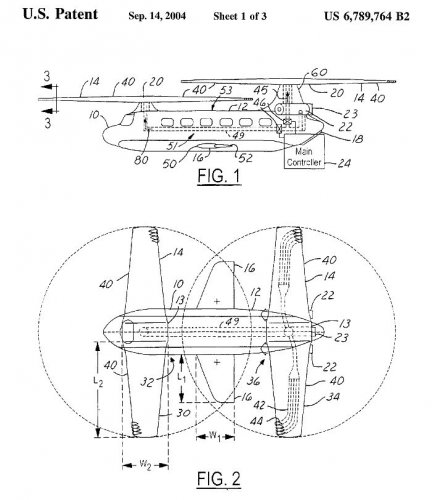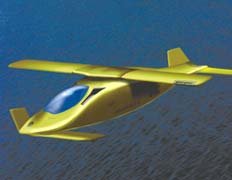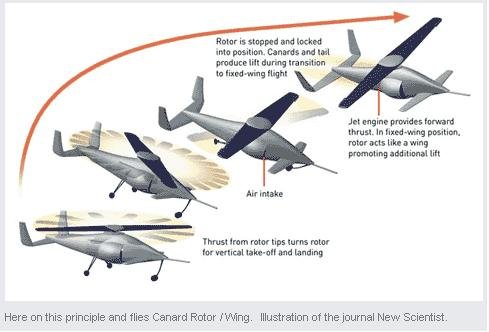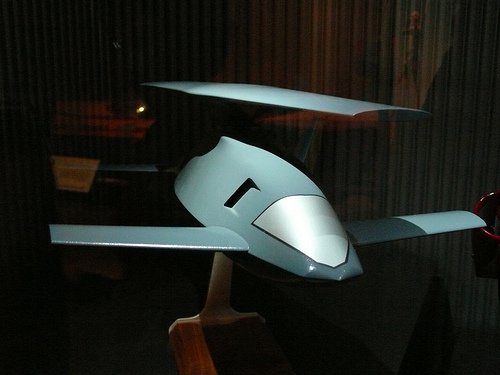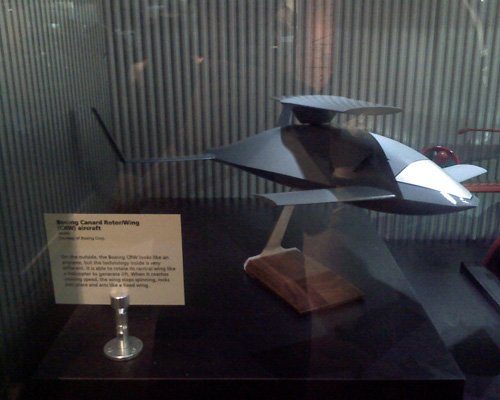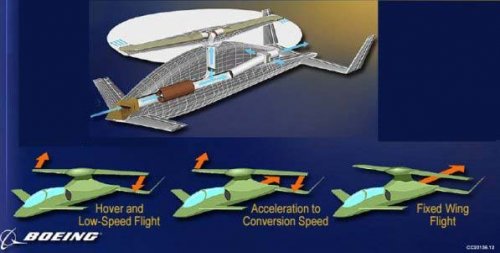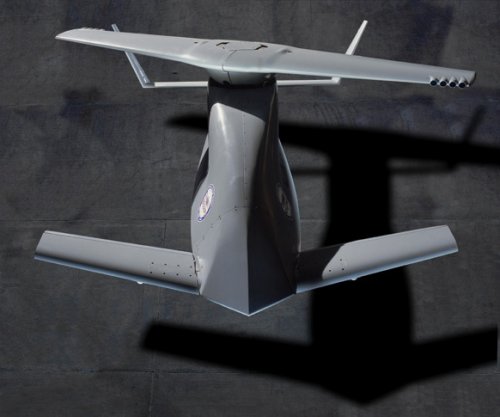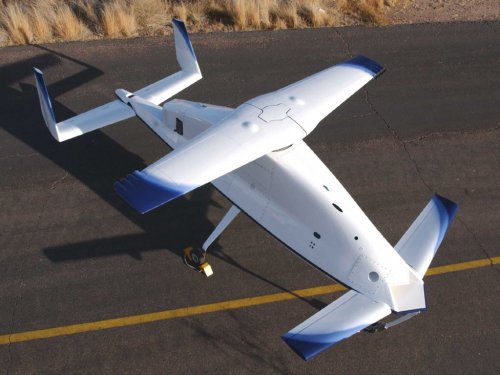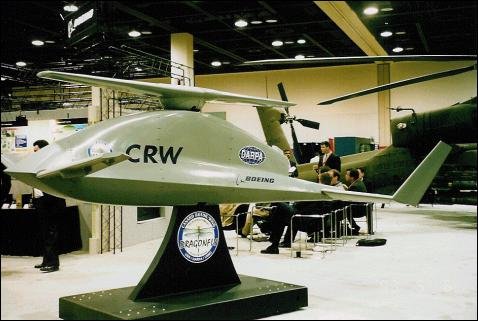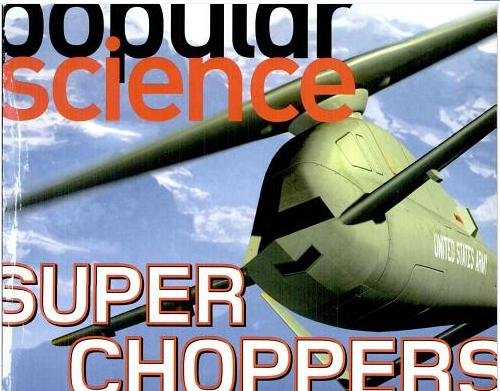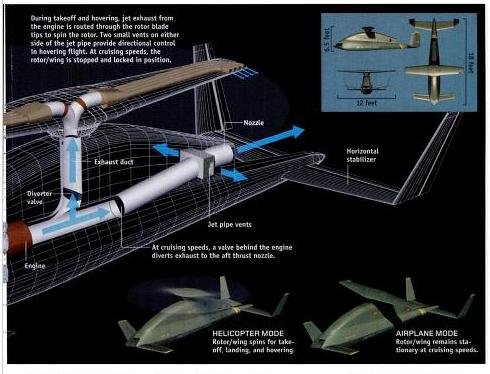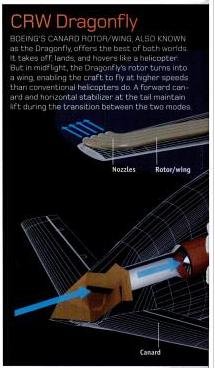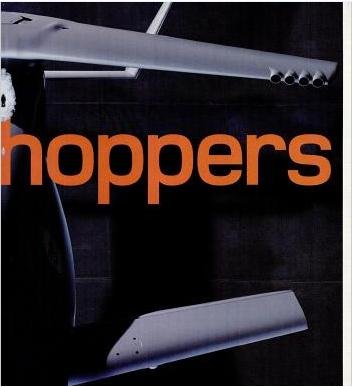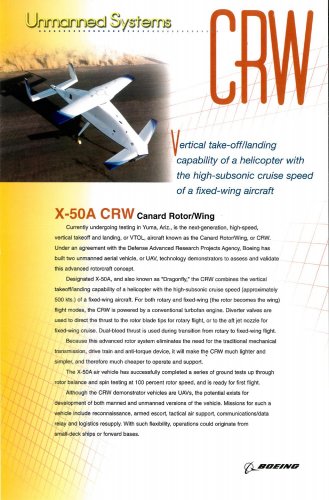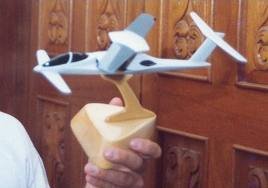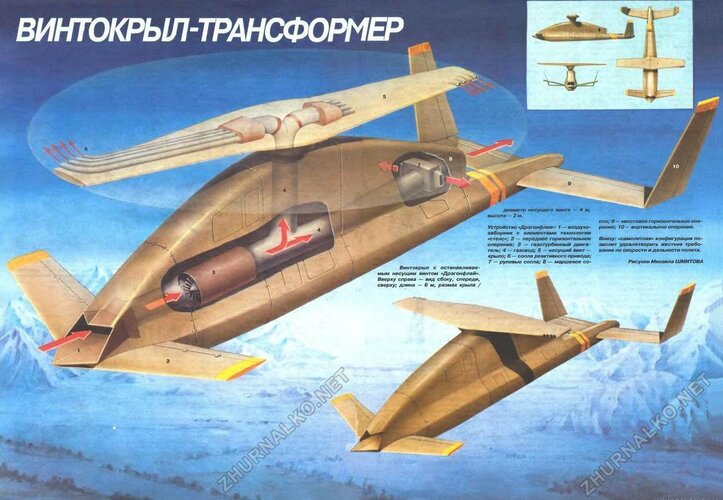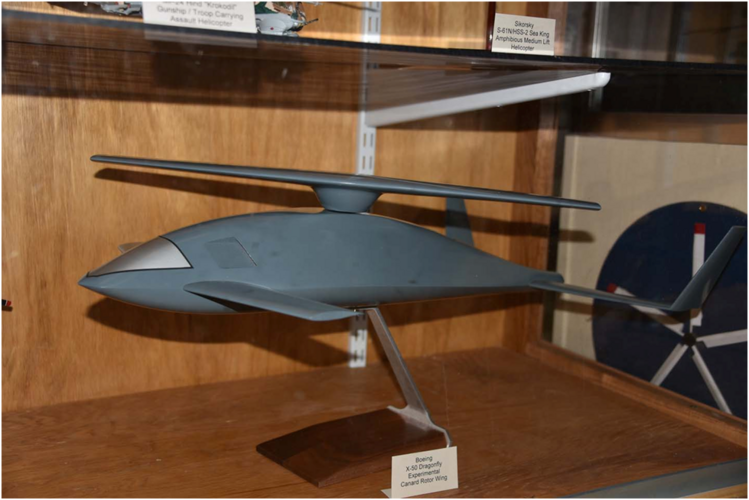You are using an out of date browser. It may not display this or other websites correctly.
You should upgrade or use an alternative browser.
You should upgrade or use an alternative browser.
McDonnell Douglas & Boeing canard rotor wing (CRW) concepts
- Thread starter flateric
- Start date
- Joined
- 26 May 2006
- Messages
- 32,695
- Reaction score
- 11,962
Matej
Multiuniversal creator
Was somebody lucky to save any high-res (1000 pixels and more) photo of the X-50? I found out that I dont have any.
Nice addition to the story:
link
Nice addition to the story:
Despite the sorry story of the X-50 Canard Rotor/Wing (CRW) demonstrators, both of which crashed while still hovering, Boeing has not given up on the idea of a rotorcraft that can stop its rotor in flight and thus reach higher speeds than a helicopter.
Spotted during a visit to Boeing Mesa this week was this subscale stopped-rotor demonstrator built and flown by a Boeing employee in his own time...
link
Matej
Multiuniversal creator
Thank you. I will try to contact some persons that should have something to offer.
Matej
Multiuniversal creator
flateric said:Nice X-50 photo
Another photo of that mockup.
Attachments
- Joined
- 26 May 2006
- Messages
- 32,695
- Reaction score
- 11,962
Hi,
http://books.google.com.eg/books?id=iAAAAAAAMBAJ&pg=PA51&dq=one+blade+to+lift+copter&hl=ar&ei=DwivTJWrFoySOpT7-IYG&sa=X&oi=book_result&ct=result&resnum=9&ved=0CEwQ6AEwCA#v=onepage&q&f=true
http://books.google.com.eg/books?id=iAAAAAAAMBAJ&pg=PA51&dq=one+blade+to+lift+copter&hl=ar&ei=DwivTJWrFoySOpT7-IYG&sa=X&oi=book_result&ct=result&resnum=9&ved=0CEwQ6AEwCA#v=onepage&q&f=true
Attachments
- Joined
- 13 June 2007
- Messages
- 2,029
- Reaction score
- 2,256
Looks like a dophin with a rotor...
I love the X-50A, looks so futuristic...
Would have increasing the rotor ( or should I say wing? ) length have solved much of it problems?
Would dual rotors ( counterrotating? ) made it produce more lift? Would dual wings make it a better aircraft?
Now I want to go and make a X-50x...
I love the X-50A, looks so futuristic...
Would have increasing the rotor ( or should I say wing? ) length have solved much of it problems?
Would dual rotors ( counterrotating? ) made it produce more lift? Would dual wings make it a better aircraft?
Now I want to go and make a X-50x...
Scott Kenny
ACCESS: Above Top Secret
- Joined
- 15 May 2023
- Messages
- 6,051
- Reaction score
- 4,908
The thing is, I've seen smaller RC CRWs flying around, and they seem to have a very long fuselage relative to the rotor.
Wonder if that was to get the horizontal stabilizer out of the rotor wash?Have never seen it with a T-tail before !
stever_sl
ACCESS: Restricted
- Joined
- 31 August 2010
- Messages
- 35
- Reaction score
- 105
Having worked on CRW, I continue to this day to be frustrated by how mismanaged the program was. My first day happened to be at an offsite group meeting where the concept was described in detail, which got me up to speed really quickly. Having worked on mostly rotorcraft and STOVL fixed-wing aircraft up to that point, I nearly fell out of my chair when the chart was put up showing 55+% propulsion system losses incurred by forcing the engine exhaust gases through ductwork, up the rotor mast, through some magic sort of gas-tight fitting that rotated with the rotor itself, then out through the length of each rotor blade before finally being ejected at the tips. That's far less efficient than conventional shaft-driven rotors, even if you include the antitorque provisions they have to possess. It meant that every time we came up with something for a particular customer-defined proposal, our CRW offering had to have twice the engine power as everybody else had, which burned twice the fuel for equivalent payload-radius, which made the airframe twice as big, which made it twice as heavy, which made it twice the cost. (Roughly, in all cases.) As long as we stuck with gas-driven rotors, we were never going to be able to compete with conventional rotorcraft, because potential customers just weren't requiring the kinds of speeds that were CRW's only advantage. Why would they, given that nobody had ever demonstrated that a full-payload VTOL machine could go that fast? I spent my years on that program trying to at least get the shaft-drive option studied but there were key people blocking such a move. Why? Because the underlying patent describing CRW was framed around gas-driven rotors, and so there was enormous management pressure to stick to that.
Then when X-50A came along, we had an opportunity to at least prove that a rotor could be stopped and started in flight. (Herrick had done it decades earlier, but was his a true "driven" rotor or more of a gyroplane?) I was very concerned when I saw that the test plan involved ground runs, then low hovers, then higher out-of-ground-effect hovers, then partial transitions, etc until at the end we would finally do a full transition. We were going to be spending an inordinate amount of time in the most dangerous flight regions, risking the aircraft on every flight, before we ever got to the point of doing the only thing we needed to prove in order to validate the entire CRW concept. And, sure enough, Ship One crashed while doing something that thousands of rotorcraft do every day, simply hovering.
At this point we still had a golden opportunity. Tony Tether, who was Director of Advanced Research Projects (including X-50A) at DARPA, gave an interview to an industry magazine where he outlined what he thought Boeing should do next. Show some guts, basically. Get Ship Two in the air as soon as possible and see what happens. If it crashed too, we'd take the lessons learned and use them to create a new CRW X-plane, using DARPA funding. So all we had to do was put the finishing touches on the 2nd Dragonfly and get it in the air. Instead our managers got cold feet, and sent the plane to the wind tunnel for more testing, while simultaneously doing fresh sets of analyses for stability and control and performance. Months went by, at the end of which we had 3 sets of data: Wind tunnel, analytical, and flight test (from Ship One) - and predictably, they didn't agree in key areas. So more time was spent trying to resolve the differences. In the end we went back to flight test after a very long delay, and it wasn't long before Ship Two was wrecked during hover testing, just like Ship One. Only by that point DARPA had realized that Boeing's managers weren't risk-takers, and so they gave the remaining program funds to the Groen Bros for their far-out proposal to put a huge rotor on top of a C-130. Needless to say, nothing came of that either. But having thoroughly alienated DARPA, and being unwilling to spend its own money, Boeing abandoned CRW and we were all reassigned to other things.
I will always believe that if we had switched from reaction-driven to shaft-driven rotors, CRW would have been much more competitive with conventional rotorcraft in the proposals we entered, and if we'd just done what DARPA expected with X-50A there would have been an X-XX follow-on demonstrator that incorporated all of the many things we learned from Dragonfly. For that matter, if we had just bypassed the hover testing and gone straight to in-flight rotor conversion via a ballistic rail launcher, we would at least have had a fighting chance of achieving proof-of-concept in the only flight regime that we really had to demonstrate. But when management is not just risk-averse but risk-intolerant, working with DARPA is bound to be a bad experience for everybody.
Then when X-50A came along, we had an opportunity to at least prove that a rotor could be stopped and started in flight. (Herrick had done it decades earlier, but was his a true "driven" rotor or more of a gyroplane?) I was very concerned when I saw that the test plan involved ground runs, then low hovers, then higher out-of-ground-effect hovers, then partial transitions, etc until at the end we would finally do a full transition. We were going to be spending an inordinate amount of time in the most dangerous flight regions, risking the aircraft on every flight, before we ever got to the point of doing the only thing we needed to prove in order to validate the entire CRW concept. And, sure enough, Ship One crashed while doing something that thousands of rotorcraft do every day, simply hovering.
At this point we still had a golden opportunity. Tony Tether, who was Director of Advanced Research Projects (including X-50A) at DARPA, gave an interview to an industry magazine where he outlined what he thought Boeing should do next. Show some guts, basically. Get Ship Two in the air as soon as possible and see what happens. If it crashed too, we'd take the lessons learned and use them to create a new CRW X-plane, using DARPA funding. So all we had to do was put the finishing touches on the 2nd Dragonfly and get it in the air. Instead our managers got cold feet, and sent the plane to the wind tunnel for more testing, while simultaneously doing fresh sets of analyses for stability and control and performance. Months went by, at the end of which we had 3 sets of data: Wind tunnel, analytical, and flight test (from Ship One) - and predictably, they didn't agree in key areas. So more time was spent trying to resolve the differences. In the end we went back to flight test after a very long delay, and it wasn't long before Ship Two was wrecked during hover testing, just like Ship One. Only by that point DARPA had realized that Boeing's managers weren't risk-takers, and so they gave the remaining program funds to the Groen Bros for their far-out proposal to put a huge rotor on top of a C-130. Needless to say, nothing came of that either. But having thoroughly alienated DARPA, and being unwilling to spend its own money, Boeing abandoned CRW and we were all reassigned to other things.
I will always believe that if we had switched from reaction-driven to shaft-driven rotors, CRW would have been much more competitive with conventional rotorcraft in the proposals we entered, and if we'd just done what DARPA expected with X-50A there would have been an X-XX follow-on demonstrator that incorporated all of the many things we learned from Dragonfly. For that matter, if we had just bypassed the hover testing and gone straight to in-flight rotor conversion via a ballistic rail launcher, we would at least have had a fighting chance of achieving proof-of-concept in the only flight regime that we really had to demonstrate. But when management is not just risk-averse but risk-intolerant, working with DARPA is bound to be a bad experience for everybody.
- Joined
- 3 June 2011
- Messages
- 17,342
- Reaction score
- 9,090
As someone who worked on the DARPA Heliplane we had a somewhat similar issue. We were diverting turbofan bypass air through a plenum, into the rotor head, and out through the blades to tip jets. "Wait this AIAA paper said the Hughes Hotcycle had 0% leakage through their rotating joints. How'd they do that?" *crickets*Having worked on CRW, I continue to this day to be frustrated by how mismanaged the program was. My first day happened to be at an offsite group meeting where the concept was described in detail, which got me up to speed really quickly. Having worked on mostly rotorcraft and STOVL fixed-wing aircraft up to that point, I nearly fell out of my chair when the chart was put up showing 55+% propulsion system losses incurred by forcing the engine exhaust gases through ductwork, up the rotor mast, through some magic sort of gas-tight fitting that rotated with the rotor itself, then out through the length of each rotor blade before finally being ejected at the tips.
stever_sl
ACCESS: Restricted
- Joined
- 31 August 2010
- Messages
- 35
- Reaction score
- 105
Our managers (and the owner of the patent of course) got so focused on "you can eliminate the entire antitorque system" that they were completely blind to the fact that we were creating several more problems that were new and unique. The worst configuration that I think we created was for Joint Heavy Lift, and that sketch has been posted in this group before, many years ago. Too big, too heavy, too ugly!As someone who worked on the DARPA Heliplane we had a somewhat similar issue. We were diverting turbofan bypass air through a plenum, into the rotor head, and out through the blades to tip jets. "Wait this AIAA paper said the Hughes Hotcycle had 0% leakage through their rotating joints. How'd they do that?" *crickets*
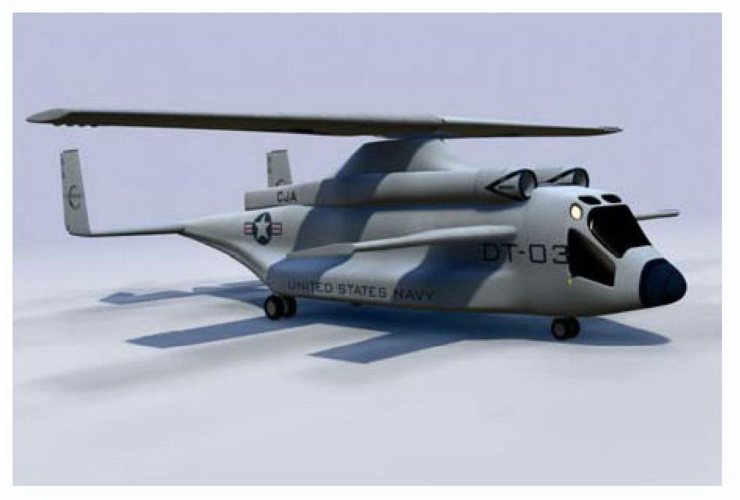
Last edited:
stever_sl
ACCESS: Restricted
- Joined
- 31 August 2010
- Messages
- 35
- Reaction score
- 105
Our managers (and the owner of the patent of course) got so focused on "you can eliminate the entire antitorque system" that they were completely blind to the fact that we were creating several more new and unique problems instead. The worst configuration that I think we created was for Joint Heavy Lift, which was posted in this group years ago. Too big, too heavy, too ugly! View attachment 706121As someone who worked on the DARPA Heliplane we had a somewhat similar issue. We were diverting turbofan bypass air through a plenum, into the rotor head, and out through the blades to tip jets. "Wait this AIAA paper said the Hughes Hotcycle had 0% leakage through their rotating joints. How'd they do that?" *crickets*
Scott Kenny
ACCESS: Above Top Secret
- Joined
- 15 May 2023
- Messages
- 6,051
- Reaction score
- 4,908
You could have retired at about 24!I wish I had collected $1 for every time I have heard this sort of sad tale from industry. Unfortunate truth that leadership believes it always knows best.
Similar threads
-
-
-
Sikorsky S-56 twin tail rotor experimental versions
- Started by robunos
- Replies: 0
-
Beechcraft AT-11 rotor test aircraft
- Started by Stingray
- Replies: 0
-
Boeing Vertol/Grumman BV-222 tilt-rotor projects
- Started by fightingirish
- Replies: 27

